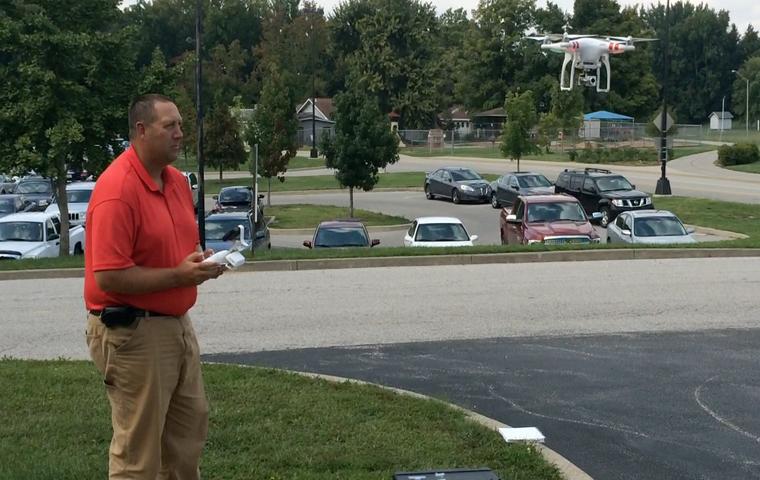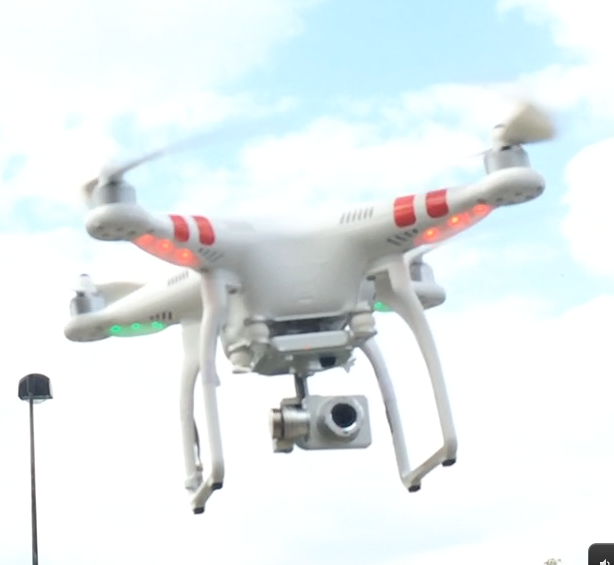People meandering about on USI’s campus this August may have witnessed a four-limbed flying machine buzzing about the crisp summer sky.
The white, alien-esque contraption is no space-aged spy device; it’s Mike Fetscher’s quad copter—more commonly referred to as a “drone.”
Fetscher, the coordinator of instructional broadcasting for the College of Nursing and Health Professions, uses his personal drone to capture stunning aerial visuals of USI’s scenery.
“We have a beautiful campus,” he said. “(I’m) just trying to show off the beauty this campus has from a different perspective.”
As a photography and video lover, Fetscher said he always tries to follow up-and-coming “tech-trends.”
“I had seen these things kind of on the forefront,” he said. “A lot of people use them for aerial photography.”
Although he purchased the copter in November, Fetscher captured most photography and video of USI during the summer months when he had more free time and less people were out and about. But he plans to get shots during all four seasons for a special project.
He said he also plans to use aerial footage to provide a better view of campus for perspective students.
“There are recruiting videos out there right now for colleges, but could you imagine seeing, if you’re a perspective student, ‘This is where I’m going to live, here’s some sand volleyball courts right in the middle of where I am going to live for the next four years’,” he said.
Beauty shots and promotion videos aren’t the only perks the eye of a drone provides.
“The first two days of school, I just snuck out and took a shot of the parking lot, put it on the college of nursing’s Facebook page and said, ‘If you’re coming out here (to USI), here’s where you want to look,” he said.
Fetscher said the copter is safe and pedestrians shouldn’t fear a catastrophic crash landing.
“With (its) GPS, it knows where it took off from, so if the battery starts running low, or who knows, maybe there’s electrical interference, if it’s not already 60 feet high, it will go up to 60 feet; it will fly directly above where it took off from and it will slowly land.”
After several tests, Fetscher found that it always lands within one or two feet from its point of liftoff.
“I did a lot of research before I bought one. There are still a lot of regulations and there’s still a lot of grey area, which I wish would get cleared up,” he said. “But some of the regulations are: how close you can fly to an airport—for obvious reasons—they (also) want you to stay under 400 feet.”
Fetscher’s drone, which is a DJI Phantom model, is pre-programmed to go no higher than 390 feet.
The right to privacy is not in the Constitution, but Associate Professor of Communications Wayne Rinks said it has been derived over time through judicial review and statutory action.
“You have to deal with the idea that we have a right, we Americans, have a right to our seclusion, our right to be left alone,” Rinks said. “And we have a civil tort that involves intrusion.”
As drone popularity increases, a lot of grey area still exists as federal courts argue law surrounding the differences between commercial and amateur drone usage.
“It used to be, in English common law, that a person’s real estate property extended upward all the way into the heavens, seriously,” he said. “It wasn’t until 1946 that the U.S. Supreme Court had a decision that basically defines the airspace over property.”
In the case U.S. v. Causby, a North Carolina chicken farmer sued an airline for “disturbing” his chickens, which prevented them from laying as many eggs.
“The question became is the airspace above your property public or private,” Rinks said.
There are unresolved issues related to drones and news gathering.
“The news media is not supposed to be hindered by the government in their day-to-day news gathering operations,” he said. “There are regulations that go so far as to say the news media can’t fly a drone over a sight–crime scene perhaps–and gather information. Well, that’s certainly a restriction on news gathering.”
On the flip side, the media does not have special rights.
“There is no special class of citizens called journalists that can break laws,” Rinks said.
Several states now have laws banning the use of drone footage in court cases.
“I don’t know what’s going to happen with this thing on the drones, it’s pretty complicated,” he said. “It’s a fairly new technology and more and more people are getting into it and as we do, the legal system is going to have to grapple with these things.”
Until regulatory action for the remote controlled aircraft is settled, Fetscher can continue to gather footage freely.




